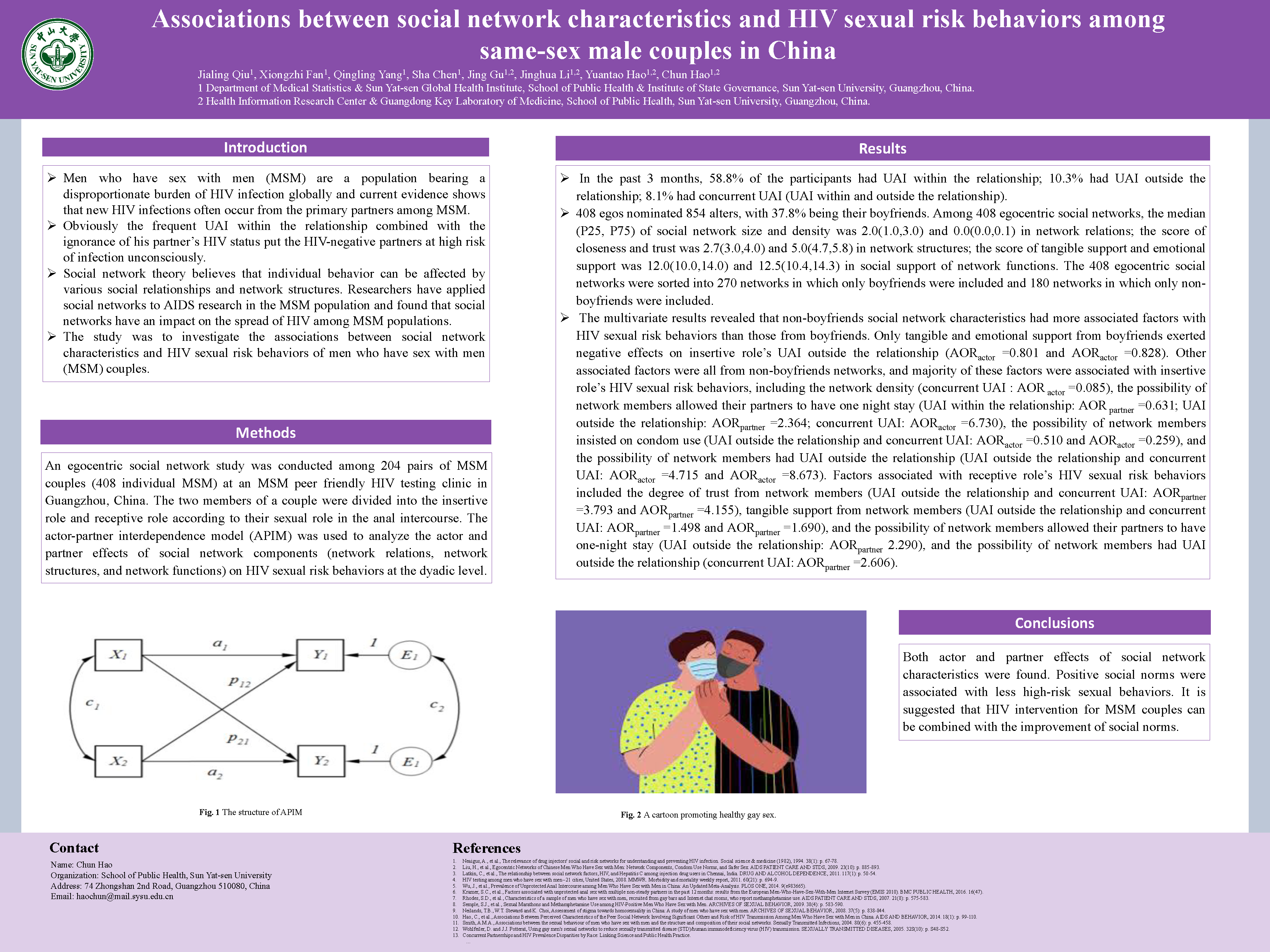
Associations between social network characteristics and HIV sexual risk behaviors among same-sex male couples in China
Jialing Qiu, Xiongzhi Fan, Qingling Yang, Sha Chen, Jing Gu, Jinghua Li, Yuantao Hao, Chun Hao
Objective: To investigate the associations between social network characteristics and HIV sexual risk behaviors of men who have sex with men (MSM) couples.
Methods: An egocentric social network study was conducted among 204 pairs of MSM couples (408 individual MSM) at an MSM peer friendly HIV testing clinic in Guangzhou, China. The two members of a couple were divided into the insertive role and receptive role according to their sexual role in anal intercourse. The actor-partner interdependence model (APIM) was used to analyze the actor and partner effects of social network components (network relations, network structures, and network functions) on HIV sexual risk behaviors at the dyadic level.
Results: In the past 3 months, 58.8% of the participants had unprotected anal intercourse (UAI) within the relationship; 10.3% had UAI outside the relationship; 8.1% had concurrent UAI (UAI within and outside the relationship). 408 egos nominated 854 alters, with 37.8% being their boyfriends. Among 408 egocentric social networks, the median (P25, P75) of social network size and density was 2.0(1.0,3.0) and 0.0(0.0,0.1) in network relations, the score of closeness and trust was 2.7(3.0,4.0) and 5.0(4.7,5.8) in network structures, the score of tangible support and emotional support was 12.0(10.0,14.0) and 12.5(10.4,14.3) in social support of network functions. The 408 egocentric social networks were sorted into 270 networks in which only boyfriends were included and 180 networks in which only non-boyfriends were included. The multivariate results revealed that non-boyfriends social network characteristics had more associated factors with HIV sexual risk behaviors than those from boyfriends. Only tangible and emotional support from boyfriends exerted negative on insertive role’s UAI outside the relationship (AORactor =0.801 and AORactor =0.828). Other associated factors were all from non-boyfriends networks, and majority of these factors were associated with insertive role’s HIV sexual risk behaviors, including the network density (concurrent UAI: AOR actor =0.085), the possibility of network members allowed their partners to have one-night stay (UAI within the relationship: AOR partner =0.631; UAI outside the relationship: AORpartner =2.364; concurrent UAI AORactor =6.730), the possibility of network members insisted on condom use (UAI outside the relationship and concurrent UAI AORactor =0.510 and AORactor =0.259), and the possibility of network members had UAI outside the relationship (UAI outside the relationship and concurrent UAI AORactor =4.715 and AORactor =8.673). Factors associated with receptive role’s HIV sexual risk behaviors included the degree of trust from network members (UAI outside the relationship and concurrent UAI: AORpartner =3.793 and AORpartner =4.155), tangible support from network members (UAI outside the relationship and concurrent UAI: AORpartner =1.498 and AORpartner =1.690), and the possibility of network members allowed their partners to have one-night stay (UAI outside the relationship: AORpartner 2.290), and the possibility of network members had UAI outside the relationship (concurrent UAI: AORpartner =2.606).
Conclusion: Both actor and partner effects of social network characteristics were found. Positive social norms were associated with less high-risk sexual behaviors. It is suggested that HIV intervention for MSM couples can be combined with the improvement of social norms. 
← Schedule

